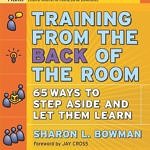Follow-Ups (Spaced Practice) for All “Training from the BACK of the Room” (TBR) Practitioner Classes

For participants who have attended an in-person, 2-day “Training from the BACK of the Room” (TBR) Practitioner Class, the “real work” begins after the class is over – with “Follow-Ups,” of course!
If you’re a regular blog reader here, you already know that brain scientists call Follow-Ups “spaced practice.” Spaced practice (small segments of practice time done over a few days, weeks, or months) is better than “massed practice” (one large chunk of practice done in one sitting). Spaced practice helps learners move content into long-term memory and then use the information in practical ways.
The Follow-Ups here are for the participants of any official 2-day TBR Practitioner Class taught by one of the members of the TBR Certified Trainers team.
Even if you did not attend a TBR class, many of the numbered activities that are listed below will enhance your own classroom and online instruction. And, of course, you can create Follow-Ups like these for your own classes and training programs.
 READ ONE: Go back through your class notes and materials and read at least one note-taking page, one workbook article, one book chapter, or one website resource each week. This will deepen your understanding and application of the concepts through future weeks and months.
READ ONE: Go back through your class notes and materials and read at least one note-taking page, one workbook article, one book chapter, or one website resource each week. This will deepen your understanding and application of the concepts through future weeks and months.
CHOOSE ONE: From your readings, or from the activities listed below, choose one strategy to use in your next class, presentation, or training.
USE ONE: Use your chosen strategy and then record the results in a training journal so that you’ll remember how it worked and what, if anything, you might change next time around to make it work even better.
DO ONE: Each week, do one of the activities below.
 1. Read the blog post “What to Do When the Training Day is Over and the Real Work Begins.”
1. Read the blog post “What to Do When the Training Day is Over and the Real Work Begins.”
2. Read “Holding Onto What You’ve Learned.”
3. Go to Slides About Creating Effective Slide Presentations, scroll down the page, and choose one slide presentation to view (they are all short, image-rich presentations). If you use slides when teaching or training, make a commitment to change at least one element in your own slide deck (examples: font size or type, photo usage, color scheme, amount of text per slide, etc.).
4. Scroll through and choose one of the slide presentations on Slides about Learning, Teaching, and Training to view. Plan to apply one or more of the ideas you’ve learned from the slides the next time you teach or train others.
5. Go to Videos about the Human Brain and Learning and view one of the short, interesting videos posted there that you haven’t yet seen.
6. Finally, if you haven’t already done so, be sure to click on the blog post below and then download, print, and cut out your own Pocket Cards to help you gain more from this spaced practice: Enhancing ANY Learning Experience with Pocket Cards (Set 2).